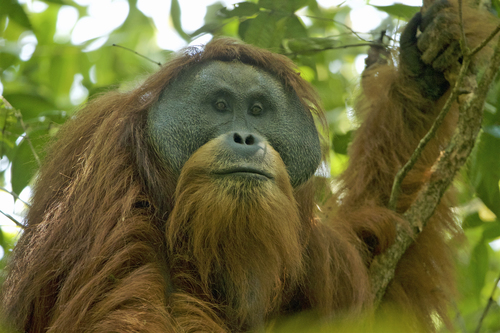
Tapanuli orangutan
Pongo tapanuliensis, the Tapanuli orangutan, captivates with its unique frizzy hair and lively vocalizations. Endemic to Sumatra's Batang Toru forests, it plays a crucial role in the ecosystem by aiding seed dispersal, yet faces critical endangerment due to habitat loss.
30-40 years
Lifespan
30.0 kg
Weight
Height: 1.25 - 1.5 m
Size
Brown, Grey, Red, Black, Orange
Color
12-15 years
Age of Sexual Maturity
3 years
Age of Weaning
2.7 mph
Top Speed
Critically Endangered
Conservation Status
Decreasing
Population Trend
Characteristics
The Tapanuli orangutan, found only in the Batang Toru ecosystem of Sumatra, is distinguished by its frizzy hair, smaller skull, and unique vocalizations. Critically endangered, with fewer than 800 individuals, this species relies on dense rainforest habitats and plays a vital role in seed dispersal.
Distribution Range of the Tapanuli orangutan
Pongo tapanuliensis, commonly known as the Tapanuli orangutan, is native to the island of Sumatra in Indonesia. Specifically, it is found in the Batang Toru ecosystem in the Tapanuli region of North Sumatra.
Tapanuli orangutan's Habitat
Environmental Conditions
The Tapanuli orangutan inhabits tropical rainforests, characterized by high humidity and significant rainfall throughout the year. The region features a mountainous terrain with elevations ranging from 300 to 1,300 meters above sea level. The climate in this area is typically warm and humid, with temperatures averaging between 21°C and 28°C.
Ecological Niche
The Tapanuli orangutan is primarily arboreal, spending most of its life in the forest canopy. It plays a crucial role in seed dispersal, contributing to forest regeneration and biodiversity. This orangutan species relies on a diet consisting mainly of fruits, but it also consumes leaves, bark, and insects, adapting its diet based on seasonal fruit availability. The Tapanuli orangutan's ecological niche is closely tied to the preservation of its forest habitat, which is under threat from deforestation and human encroachment.
Copyright @ Nature Style Limited. All Rights Reserved.
 English
English